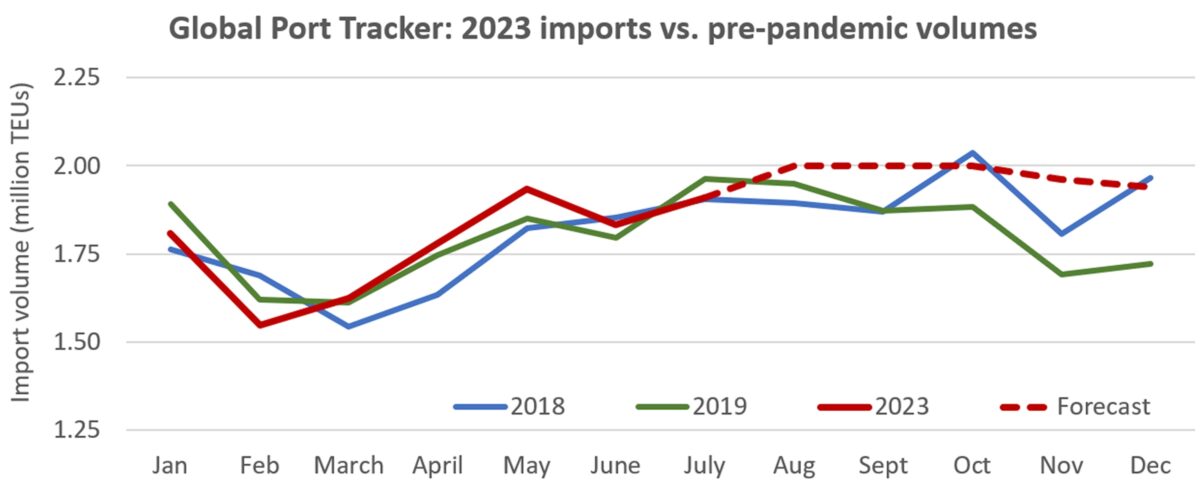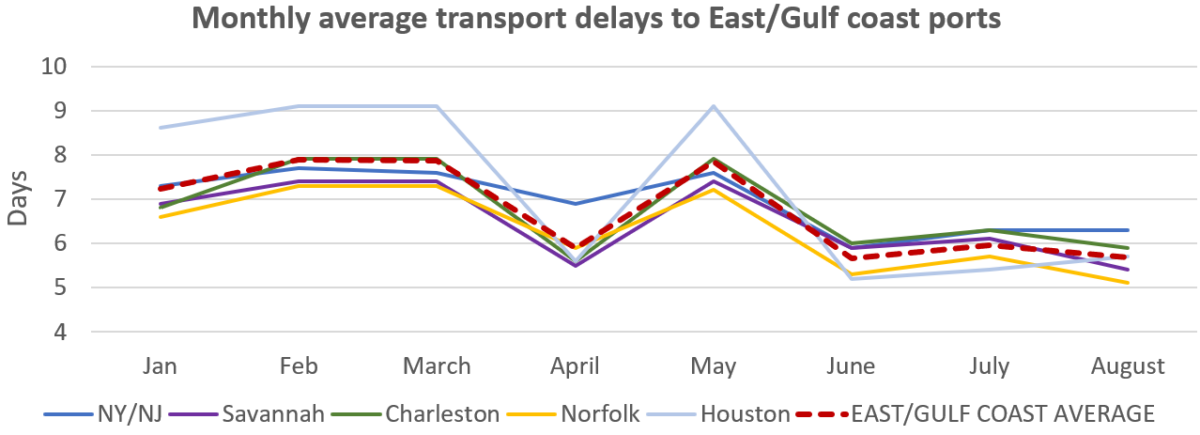Container shipping spot rates in the trans-Pacific trade started to rise in late June and remain near their highs for 2023. The question is: How much of this rate gain is driven by peak season demand, and how much by shipping lines intentionally constraining capacity?
U.S. import numbers confirm that at least some of this rate gain is demand-driven.
On Monday, Descartes reported that U.S. ports imported 2,196,268 twenty-foot equivalent units in August, up 0.4% from July and 5.5% from June. This August’s volumes were 2.5% higher than volumes in August 2019, pre-COVID.
August imports were “fairly consistent with the rise that occurs in peak season in non-pandemic years,” wrote Chris Jones, executive vice president of industry and services at Descartes Systems Group, in the company’s monthly import report.
U.S. import volumes show “continued consistency with 2019 results,” said Jones.
‘Strong numbers’ for 2023 peak season
Another data source, Global Port Tracker, published by the National Retail Federation (NRF) and consultancy Hackett Associates, measures imports to 12 leading U.S. ports using official numbers released by the ports.
Global Port Tracker estimated that the facilities it covers handled 5% more imports in August than July. It now expects total imports to top 2 million TEUs per month for three months straight: in August through October.
“These are strong numbers and a sign retailers are optimistic about the holiday season, since they don’t import merchandise they don’t think they can sell,” said Jonathan Gold, NRF vice president for supply chain and customs policy, on Friday.
Global Port Tracker expects the ports it covers to handle a total of 22.3 million TEUs in full-year 2023, up 2% versus 2018 and 3% versus 2019, pre-pandemic.

Trans-Pacific spot rates still near 2023 highs
Trans-Pacific spot rates have stopped rising but they’ve stabilized at or near recent peak levels, implying continued pricing support from cargo demand and/or constrained ship capacity.
As of Thursday, the Drewry World Container Index (WCI) assessed Shanghai-Los Angeles spot rates at $2,254 per forty-foot equivalent unit, up 43% from late June. The Freightos Baltic Daily Index (FBX) China-North America west coast assessment was $1,877 per FEU, up 57% from late June.
The WCI Shanghai-New York index was at $3,398 per FEU on Thursday, and the FBX China-North America east coast index was at $3,062 per FEU.
These east coast indexes were up 35% and 40%, respectively, from late June.
Schedules not affected by Panama Canal
Water restrictions at the Panama Canal are receiving widespread media attention, however, container ships are continuing to transit without delay.
Descartes collects data on average transit delays for shipments to top U.S. ports, measuring the difference between the arrival date and the estimated date declared on bills of lading for inbound containerized cargo.
If the canal was impacting vessel schedules, August delays would have sequentially increased at East and Gulf coast ports. They didn’t.
Delays in New York/New Jersey; Savannah, Georgia; Charleston, South Carolina; Norfolk, Virginia; and Houston averaged 5.68 days in August, down 4.7% versus July and flat versus June.

“The drought in Panama … does not appear to be impacting U.S. container imports currently,” said Jones.
According to Hackett Associates founder Ben Hackett, “We have closely followed conditions at the Panama Canal. It now appears that the situation has had little impact on retail supply chains and is unlikely to be a problem as we head into the peak shipping season.”
Click for more articles by Greg Miller
Related articles:
- Rebound in trans-Pacific container shipping rates has stalled
- Shipping ‘traffic jam’ at Panama Canal: Why it’s not a crisis (yet)
- Shipping line Zim bets big on spot market as losses mount
- July import volumes continue to mirror pre-COVID ‘normal’
- Asia-US spot rates top contract rates for first time since 2022
- Maersk hikes 2023 guidance but warns of ‘years’ of challenges
- Trans-Pacific shipping rates rise as carriers make capacity cuts







